In General Entry you can complete any miscellaneous entries or adjustments that are needed outside of the normal accounting processes completed in Payable and Receivable, Banking Transaction, and Receipt Management. In the grid view we will see existing general entries listed (for the current month and current user or based on filter selection) with a box on the first left column where we can select to use with bulk actions, and in the other columns we will see journal number, entry no., description, date, status (All, Open, Posted, Voided), items (number of entries in general entry), who the general entry was last updated by (username will be listed here), and actions menu. Each of the columns in the grid view allow for sorting and we can click on the arrows next to the column headers to sort.

In the filter menu you can set a date, search by journal, entry no., or description, search by status (All, Open, Posted, Voided), and last updated by (username can be selected from here or can be left blank). The clear button will remove any recent selection made in the filter fields and the apply button will run the search including any changes made to the filter and display any findings in the grid view.
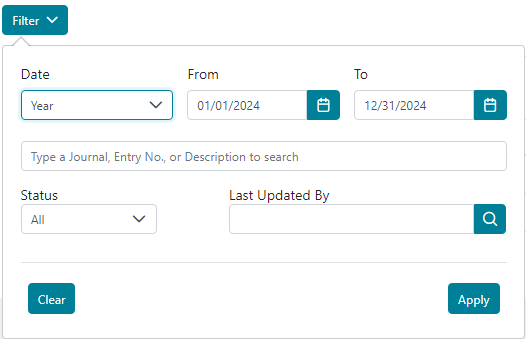
If one of the entries (or multiples) in the grid view is selected this will enable the Bulk Actions menu drop-down with options to Print, Void, Delete, Post, Unpost, and Invert Selection. Bulk Actions can be used to apply the selected menu option to an individual general entry or multiple general entries at once. An example of why we would use Bulk Actions is if we wanted to Print more than one general entry at once.
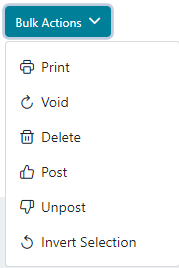
In the Actions menu, the Pencil icon is to edit the general entry, the printer icon to print the journal entry, the trash bin icon to delete the general entry, the thumbs up icon to post the general entry, the thumbs down icon to unpost the general entry, and the clockwise arrow icon to void the general entry. The trash bin, thumbs up, thumbs down, and clockwise arrow icons will display based on if the general entry is posted so when a general entry is posted we will see the icons to void and unpost (clockwise arrow and thumbs down), and when the general entry is not posted we will see the icons to delete and post (trash bin and thumbs up).

You can print or download a list of general entries using the printer or excel icons on the right above the grid view. This will print or download only the entries displayed on the grid view.

The grid view will by default display the first 15 entries and any additional entries will display in separate pages. There is a count for how many entries/items are available and how many are being displayed on the page out of those available. The arrows can be used to move between the pages.
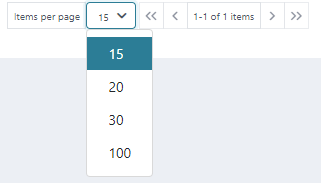
You can click on “Add General Entry” to create a general entry.

In the Add General Entry screen, we will populate an Entry Date and this is the date that the entry will display on a General Ledger report, and populate a description. There is also a memo field to add an additional note. The Cancel button at the bottom left of the screen will close out of the Add General Entry screen without creating or saving the general entry. The Save button, will create and save the general entry but will leave the Add General Entry screen open. The Save and Close button will create the general entry and will close the Add General Entry screen. The Make Entries button will create the general entry and take us directly into the general entry screen to start making entries.
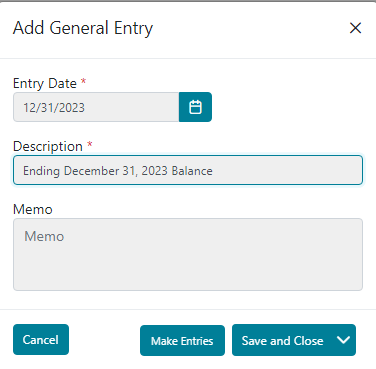
Once in the General Entry screen, we will see the Entry Date and Description that we populated in Add General Entry. On the top left of the screen, the system will display the Entry Code and this is auto populated for us based on the order of entry. On the top right of the screen the system will track Total Debit, Total Credit, and Balance and we will need to ensure that the general entries balance before the journal can be posted. We will also see displayed the journal and journal number below the balance section at the top right of the screen.
We will select the general ledger account to post to, the sub-account (breakdown within the account like an entity or project for example), department, populate an amount in debit or credit field, and description (which can be the same as the Description at the top of the screen or it can be different if needed). The Save button after the description saves the accounting entry and Cancel will clear the current accounting entry. Once the entry is saved, you can add more accounting entries. There is a pencil icon under the Actions column next to the accounting entry and this will allow us to put the accounting entry in edit mode to edit and the trash bin icon will allow us to delete the accounting entry. There is a Memo field at the bottom of the screen that can be used to add an additional note.
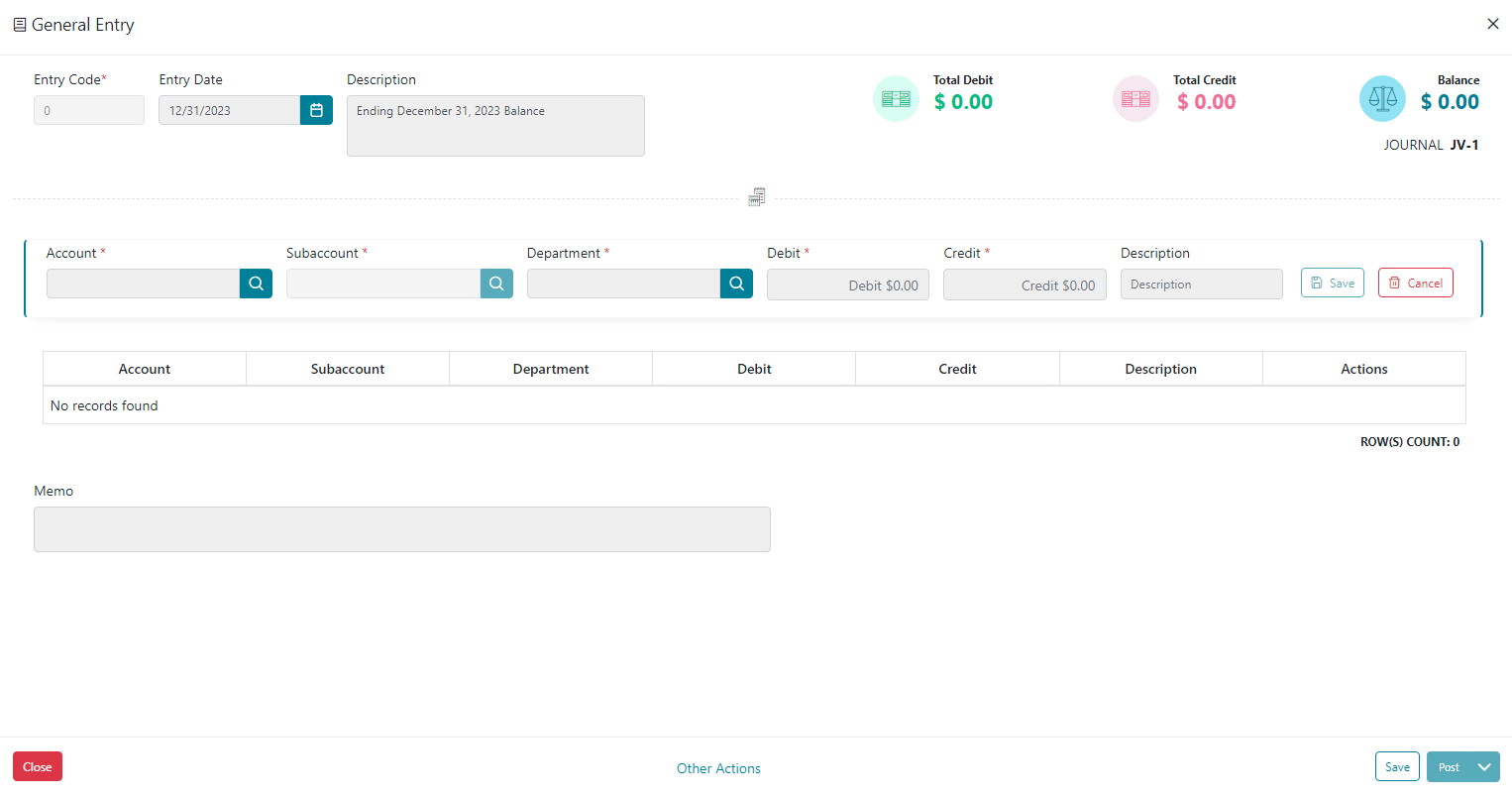
In the Other Actions menu at the bottom of the screen, we will see an option to “View Journal Entry” which will give us a printout of the entries entered and the “Delete” option which will allow us to delete the general entry before the journal is posted. The “Void” and “Unpost” options become available after the journal is posted and will be greyed out if the journal is not posted yet, but “Void” will allow us to void the journal and the system will leave the existing general entry and create additional entries to reverse the entries in the general entry and the “Unpost” option allows us to unpost the general entry so that the general entry can be edited.
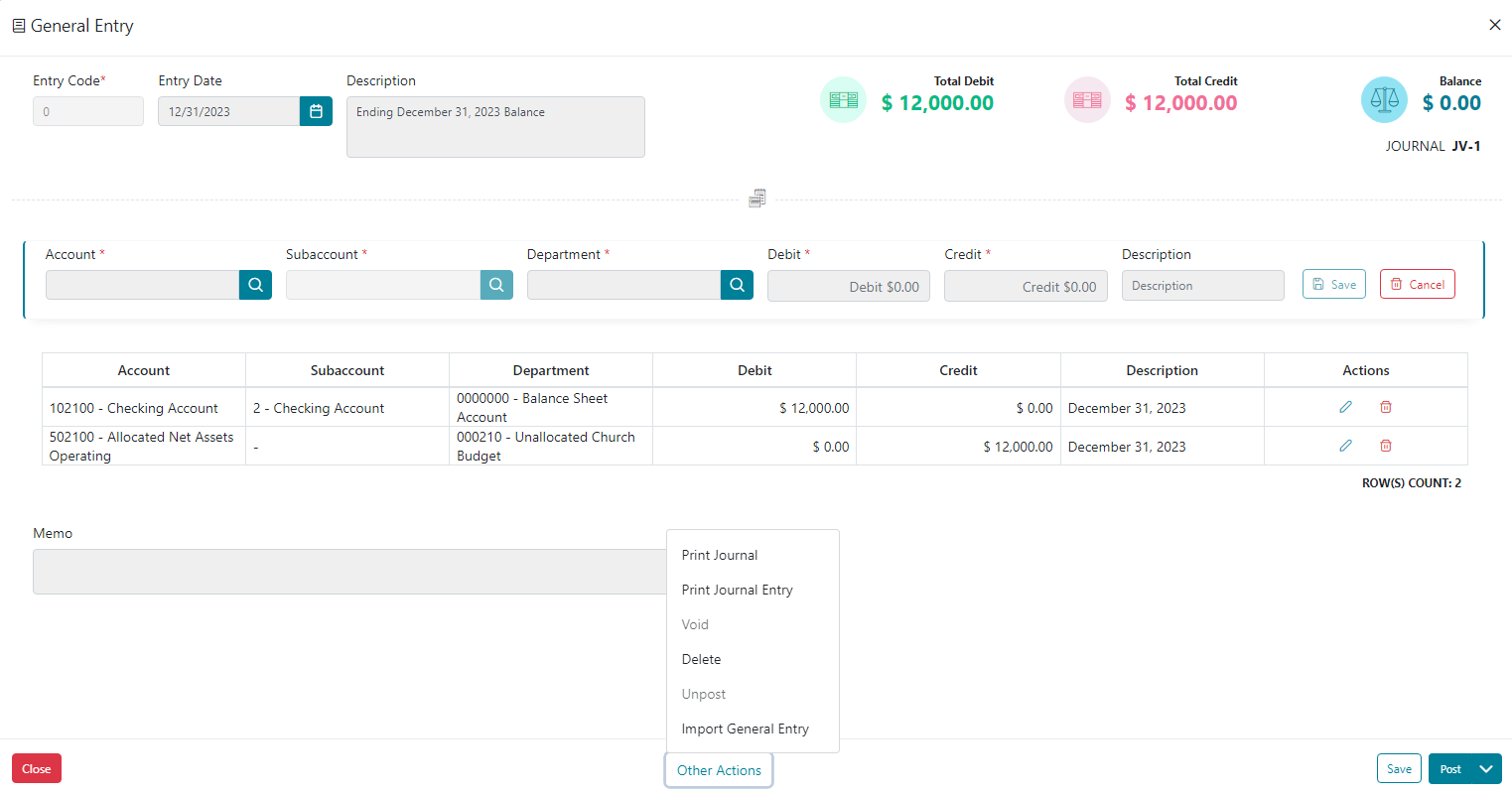
The “Post and Close” button will save the general entry, close the general entry screen, and take us back into the main General Entry screen and the journal should load in the grid view. The “Post and New” button will save the general entry, close the current general entry, and load a new screen to enter general entry. The “Post” button will save the general entry but will leave the General Entry screen open for the entries and the “Save” button will save our work in the current general entry without yet finalizing it and this will allow us to close the general entry and come back to edit it later. The “Close” button will close out of the general entry, but we would want to ensure that we save our work if needed otherwise any recent changes will be lost and the system will prompt us before closing if we are sure we want to close the current window.
